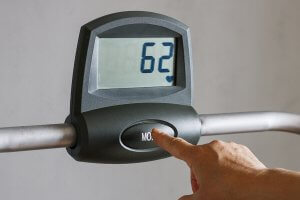How to Improve your Cardiovascular Capacity

Cardiovascular capacity is associated with the ability of the heart to pump blood and transport oxygen. A sedentary lifestyle reduces the capacity of this organ, although it’s possible to get it back in shape through aerobic exercises.
On the other hand, maintaining high cardiovascular performance is one of the basic premises in the training of both professional and amateur athletes.
The benefits of toning your cardiovascular system are many, and those include reducing the risk of heart disease, as well as strokes and heart attacks. Through cardio, you can prevent osteoporosis, strokes and cognitive problems, among others.
How does cardiovascular capacity influence aerobic capacity?
The way your heart reacts to physical strain and physical efforts is known as your aerobic capacity. When your cardiovascular system isn’t working at its best, there won’t be enough oxygen pumped into the blood.
Sometimes when we exercise we might feel tired or feel a choking sensation, or palpitations in different limbs. When these symptoms occur, it means your cardiovascular system isn’t working properly.
Or course, cardiovascular capacity can be improved by working out. Aerobic routines are a great way to get your heart working and back in shape. These workouts will gradually speed your metabolism and oxygen production capacity.
These are exercises you can easily fit into your daily life, as they don’t require much time.
Cardiovascular capacity: know your own body
Not every person can have the same cardiovascular capacity. There are many factors to take into account when planning your aerobic workout routines. Bear in mind that the training can’t be the same for a person in their twenties than for a diabetic person reaching 60. Although both need cardiovascular workouts, the routines must be widely different.
There are some mathematical formulas to determine your cardiovascular capacity. This figure will determine how your routines should be according to your weight and age. Oxygenated blood is measured in milliliters. The maximum oxygen volume value is obtained according to the number of milliliters of oxygen per minute, per kilo.

If you don’t want to use mathematical formulas to determine your cardiovascular capacities, it’s alright. Each person intrinsically knows their cardiovascular capacity and resistance level. As it is, someone who doesn’t exercise in any way will see their cardiovascular status reduced.
When you start to work out, you’ll want to see amazing results in a short period of time. In truth, you should start slowly and not overdo it. Remember, resistance training is a matter of being constant.
Tips to start improving cardiovascular capacity
The first thing that comes to mind when thinking about improving cardiovascular capacity is the duration of the exercises. Especially for those who are out of shape, the abyss between an optimal cardiovascular capacity and their daily reality seems too big.
To improve your heart’s condition you must be consistent in your training. You don’t have to work out for hours on end at the gym, but you have to be committed to doing resistance training for at least 30 minutes, three times a week.
Exercises to improve your cardiovascular capacity
It’s not necessary to go to the gym in order to oxygenate your body better. With the exception of those medical cases when any and all workouts need to be supervised by a specialist, you can work out at home with no contraindications.
From the following list, you should choose those exercises that suit you the most. Remember as you become fitter, you should include them in all of your routines.
Different types of jumps
The effort you need to jump raises the heart rate considerably. All that is needed is a step, bench or sturdy surface that rises a few centimeters from the ground.
You can jump with both legs at the same time or alternating legs. If you’re an absolute beginner, ten jumps per day should be enough to get your heart pumping.

Climbing stairs
Among all aerobic routines, beginners can practice in their daily lives, climbing the stairs is definitely one of the easiest. Five minutes a day of climbing up the stairs can give your cardiovascular capacity a boost.
Punching the air
Even without a boxing bag, cardiovascular exercises can be performed by throwing fists into the air, punching strongly and with control, just as if you were hitting an opponent. The correct way to do this is by placing your closed hands right before your face, at eye level. If you’re an absolute beginner, 30 punches with each arm will be enough as a starting routine.

Scissor jumps
To improve cardiovascular resistance, scissor jumps can be fun and effective. This exercise consists of placing one foot in front of the other, with a distance between each foot of about a step. When you jump, one foot goes forward and the other back. When you jump again, alternate your feet to scissor them in the air. To start your cardiovascular training, 20 jumps should be enough.

As you can see, having a stronger heart and a better cardiovascular capacity isn’t a matter of money but one of effort. You need to be committed to your own health to enjoy the desired results.
Cardiovascular capacity is associated with the ability of the heart to pump blood and transport oxygen. A sedentary lifestyle reduces the capacity of this organ, although it’s possible to get it back in shape through aerobic exercises.
On the other hand, maintaining high cardiovascular performance is one of the basic premises in the training of both professional and amateur athletes.
The benefits of toning your cardiovascular system are many, and those include reducing the risk of heart disease, as well as strokes and heart attacks. Through cardio, you can prevent osteoporosis, strokes and cognitive problems, among others.
How does cardiovascular capacity influence aerobic capacity?
The way your heart reacts to physical strain and physical efforts is known as your aerobic capacity. When your cardiovascular system isn’t working at its best, there won’t be enough oxygen pumped into the blood.
Sometimes when we exercise we might feel tired or feel a choking sensation, or palpitations in different limbs. When these symptoms occur, it means your cardiovascular system isn’t working properly.
Or course, cardiovascular capacity can be improved by working out. Aerobic routines are a great way to get your heart working and back in shape. These workouts will gradually speed your metabolism and oxygen production capacity.
These are exercises you can easily fit into your daily life, as they don’t require much time.
Cardiovascular capacity: know your own body
Not every person can have the same cardiovascular capacity. There are many factors to take into account when planning your aerobic workout routines. Bear in mind that the training can’t be the same for a person in their twenties than for a diabetic person reaching 60. Although both need cardiovascular workouts, the routines must be widely different.
There are some mathematical formulas to determine your cardiovascular capacity. This figure will determine how your routines should be according to your weight and age. Oxygenated blood is measured in milliliters. The maximum oxygen volume value is obtained according to the number of milliliters of oxygen per minute, per kilo.

If you don’t want to use mathematical formulas to determine your cardiovascular capacities, it’s alright. Each person intrinsically knows their cardiovascular capacity and resistance level. As it is, someone who doesn’t exercise in any way will see their cardiovascular status reduced.
When you start to work out, you’ll want to see amazing results in a short period of time. In truth, you should start slowly and not overdo it. Remember, resistance training is a matter of being constant.
Tips to start improving cardiovascular capacity
The first thing that comes to mind when thinking about improving cardiovascular capacity is the duration of the exercises. Especially for those who are out of shape, the abyss between an optimal cardiovascular capacity and their daily reality seems too big.
To improve your heart’s condition you must be consistent in your training. You don’t have to work out for hours on end at the gym, but you have to be committed to doing resistance training for at least 30 minutes, three times a week.
Exercises to improve your cardiovascular capacity
It’s not necessary to go to the gym in order to oxygenate your body better. With the exception of those medical cases when any and all workouts need to be supervised by a specialist, you can work out at home with no contraindications.
From the following list, you should choose those exercises that suit you the most. Remember as you become fitter, you should include them in all of your routines.
Different types of jumps
The effort you need to jump raises the heart rate considerably. All that is needed is a step, bench or sturdy surface that rises a few centimeters from the ground.
You can jump with both legs at the same time or alternating legs. If you’re an absolute beginner, ten jumps per day should be enough to get your heart pumping.

Climbing stairs
Among all aerobic routines, beginners can practice in their daily lives, climbing the stairs is definitely one of the easiest. Five minutes a day of climbing up the stairs can give your cardiovascular capacity a boost.
Punching the air
Even without a boxing bag, cardiovascular exercises can be performed by throwing fists into the air, punching strongly and with control, just as if you were hitting an opponent. The correct way to do this is by placing your closed hands right before your face, at eye level. If you’re an absolute beginner, 30 punches with each arm will be enough as a starting routine.

Scissor jumps
To improve cardiovascular resistance, scissor jumps can be fun and effective. This exercise consists of placing one foot in front of the other, with a distance between each foot of about a step. When you jump, one foot goes forward and the other back. When you jump again, alternate your feet to scissor them in the air. To start your cardiovascular training, 20 jumps should be enough.

As you can see, having a stronger heart and a better cardiovascular capacity isn’t a matter of money but one of effort. You need to be committed to your own health to enjoy the desired results.
All cited sources were thoroughly reviewed by our team to ensure their quality, reliability, currency, and validity. The bibliography of this article was considered reliable and of academic or scientific accuracy.
- Conartritis.org. 2014. Ejercicios de capacidad cardiovascular. Extraído de: http://www.conartritis.org/wp-content/uploads/2014/lograr_ejercicios_cardio.pdf
- Sociedad Española del Corazón. Frecuencia cardíaca. Extraído de: https://fundaciondelcorazon.com/images/stories/file/controla-tu-riesgo-frecuencia-cardiaca.pdf
This text is provided for informational purposes only and does not replace consultation with a professional. If in doubt, consult your specialist.








